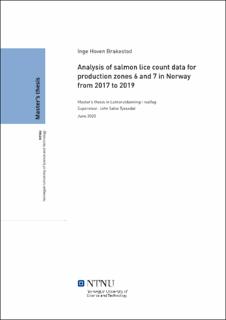| dc.contributor.advisor | Tyssedal, John Sølve | |
| dc.contributor.advisor | Jevne, Lone Sunniva | |
| dc.contributor.advisor | Aunsmo, Arnfinn | |
| dc.contributor.author | Brakestad, Inge Hoven | |
| dc.date.accessioned | 2021-09-15T17:25:44Z | |
| dc.date.available | 2021-09-15T17:25:44Z | |
| dc.date.issued | 2020 | |
| dc.identifier | no.ntnu:inspera:57287383:14046829 | |
| dc.identifier.uri | https://hdl.handle.net/11250/2778333 | |
| dc.description.abstract | Lakselus (Lepeophtheirus salmonis), er ein parasitt som er ei stor utfordring for vill laksefisk og for oppdrettsnæringa. Denne oppgåva er skriven i samarbeid med "Taskforce Lakselus", som er eit FoU-prosjekt, der målet er å "etablere grunnleggjande kunnskapar om korleis lakselus angrip oppdrettslaks og mekanismane om korleis parasitten spreier seg innad og mellom oppdrettslaks og ville bestandar av laks. Teljedata om lakselus vart lasta ned frå Barentswatch, Fiskeridirektoratet og eKlima. Barentswatch har informasjon om aktivitet i kyst- og sjøområde, og baserer seg på samarbeid mellom norske, statlege etatar og forskningsinstitusjonar. Fiskeridirektoratet er ansvarlege for fiskeri- og havbruksforvaltninga i Noreg. eKlima er ei nettside som gir tilgang til databasen for klimadata frå Meterologisk Institutt. For å analysere dataane har generaliserte lineære modellar (GLMar) som ein Poisson regresjonsmodell, ein quasi-Poisson regresjonsmodell, ein negativ-binomisk regresjonsmodell og ein null-inflatert negativ binomisk regresjonsmodell blitt tilpassa. Eit regresjonstre og ein random forest-analyse vart deretter laga. Til slutt vart det tilpassa ein generalisert additiv modell (GAM). Studien antyda at GLM-ane som vart brukt, ikkje gav ei god tilpasning til dataane. | |
| dc.description.abstract | The salmon louse (Lepeophtheirus salmonis), is a parasite that represents direct threats to wild salmonids and indirectly threats to salmon farmers and farmed salmon. This thesis is written in cooperation with ”Taskforce Salmon lice”, a R & D project, where the objectiveis to ”establish fundamental knowledge on how sea lice infest farmed salmon and the mechanisms of how the parasites spread within and between farmed and wild populations of salmonids”. Salmon lice count data were downloaded from the sources Barentswatch, the Nor-wegian Directorate of Fisheries and eKlima. Barentswatch gives information on activityin sea and coastal areas, and is based on cooperation between different Norwegian state agencies and research institutes. The Norwegian Directorate of Fisheries is responsible for fisheries and aquaculture management. Eklima is a web site which gives access to the database of climate data of the Norwegian Meteorological Institute. To analyse the data, generalized linear models (GLMs) such as a Poisson regression model, a quasi-Poisson regression model, a negative binomial regression model and a zero-inflated negative binomial regression model were fitted. A regression tree and a random forest analysis were applied. Finally, a generalized additive model (GAM) was fitted. The study suggested that the fitted GLMs did not give a good fit to the data. | |
| dc.language | | |
| dc.publisher | NTNU | |
| dc.title | Analysis of salmon lice count data for production zones 6 and 7 in Norway from 2017 to 2019 | |
| dc.type | Master thesis | |
